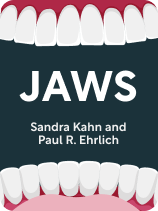

This article is an excerpt from the Shortform book guide to "Jaws" by Sandra Kahn and Paul R. Ehrlich. Shortform has the world's best summaries and analyses of books you should be reading.
Like this article? Sign up for a free trial here.
What can happen if you don’t chew enough? What should your resting jaw posture look like? What is forwardontics?
Orthodontist Sandra Kahn and ecologist Paul R. Ehrlich share three ways you can prevent and correct poor jaw structure in their book Jaws. These methods are especially important for children, whose jaws are still developing.
Continue reading for Kahn and Ehrlich’s three jaw health strategies.
How to Prevent and Correct Poor Jaw Structure
In their book Jaws, Kahn and Ehrlich suggest methods to promote strong jaw development and boost your overall oral and jaw health.
The authors add that these measures are especially effective—and important—for children. This is because childhood is a critical growth phase: Jaw development during these formative years can shape not only a person’s dental health, but their overall quality of life well into adulthood. Therefore, Kahn and Ehrlich urge parents to take particular note of these practices and help their children implement them.
(Shortform note: Young children often resist routine hygiene practices like brushing their teeth, along with the other practices we’ll discuss in this section. However, children are hard-wired to imitate the behaviors they observe in their caregivers from a very early age. Therefore, it’s wise for parents to diligently maintain these practices themselves. By modeling conscientious dental hygiene, parents increase the likelihood that their children will follow suit and establish good habits that will benefit them throughout their lifetimes.)
Practice #1: Chew More
Many modern jaw and tooth problems are the result of not chewing enough. Therefore, the most obvious solution is to chew your food more—and, if you have children, encourage them to do the same.
Kahn and Ehrlich say that you should spend at least 30 minutes of each day chewing. You can accomplish this by being mindful while eating: Take small bites and chew each mouthful thoroughly before swallowing. Food should be nearly liquid before you swallow it, so if there are any noticeable chunks left, then you haven’t chewed enough. This also has the added benefit of helping you digest your food more easily.
(Shortform note: Thoroughly chewed food requires less effort from the stomach and intestines to fully break it down and absorb nutrients. This can reduce issues like indigestion, bloating, and constipation, making you feel healthier in addition to helping strengthen your jaw.)
The authors also suggest incorporating tougher foods into your family’s meals, such as whole fruits and raw vegetables. Not only will this force you (and them) to chew more thoroughly—swallowing chunks of such foods would be very unpleasant—they’re also harder to bite through, giving your jaw a better workout. Also, avoid processed foods like packaged bread and frozen dinners as much as possible, because they’re much softer than the types of food your jaw has evolved to eat.
(Shortform note: While chewing more and incorporating tougher foods are effective ways to strengthen your jaw naturally, there are also exercises you can do to make your jaw muscles stronger. These include chewing gum, biting down on a jaw exerciser or rolled-up towel, and performing jaw-clenching and resistance exercises. However, it’s important to consult a dentist or physical therapist before starting any jaw-strengthening regimen, as excessive or improper jaw exercises can potentially lead to muscle strain or joint problems.)
Practice #2: Good Oral Posture
Kahn and Ehrlich say that how you hold your mouth normally—meaning while you’re not talking, eating, or doing something else that uses your mouth—plays a significant role in your jaw development and overall oral health. Orthodontists refer to this as oral posture.
Having proper oral posture means that your tongue rests against the roof of your mouth, your lips are closed, and your teeth are lightly touching each other. This position helps to shape your jaw and palate (the roof of your mouth), ensuring that they’re wide enough to comfortably house all of your teeth. Therefore, they advise you to maintain this position as much as possible, and encourage your children to do so as well.
(Shortform note: While oral health experts generally agree with what Kahn and Ehrlich say about oral posture, there is some disagreement over whether the teeth should be touching or slightly apart. Since one of the goals of proper oral posture is to keep the jaw relaxed, it’s best to hold your teeth in the way that feels natural for you and requires the least effort.)
Practice #3: Regular Dental Care
Finally, Kahn and Ehrlich say that preventative dental measures are also key for long-term oral health. Regular visits to the dentist can help identify early signs of issues such as crowding of teeth or potential gum diseases and can treat those conditions if you’re already suffering from them. The authors also advise getting regular dental care for your children, which they say may be even more important than getting it for yourself.
The authors also say that a good dentist or orthodontist should be familiar with forwardontics, which is more formally known as orthotropics. This is a program to evaluate your jaw structure and tooth alignment, identify problems or potential future problems, and treat those problems using various tools and techniques that promote healthy jaw development. In most cases, Kahn and Ehrlich favor this holistic approach over more common dental procedures. For instance, they say that wisdom tooth extractions are usually unnecessary and risk causing permanent damage to the patient’s jaw, teeth, or nerves.
| Counterpoint: Forwardontics Is Controversial and Unproven The efficacy of orthotropics or “forwardontics” is controversial, and its claims are generally viewed with skepticism in the wider medical and dental community. Here are a few common criticisms and concerns about this practice: 1. Forwardontics lacks robust scientific evidence from high-quality clinical studies to support its more ambitious claims about dramatically altering facial structure in adolescents and adults. 2. Some of the proposed practices and treatments carry the potential for adverse effects like muscle strain, temporomandibular joint issues, and tooth shifting if not supervised properly. 3. Forwardontic techniques require diligent compliance on the patients’ part, which can be difficult to maintain long-term. 4. The results appear to be highly variable and limited, especially in fully grown individuals. Overall, while optimizing oral posture is sensible, orthotropics’ ability to significantly remodel facial bones and structure beyond normal growth is unproven and considered pseudoscientific by most dental professionals. Qualified orthodontists can guide proper facial growth in children through proven techniques.Most experts recommend orthotropic habits for overall oral myofunctional health but remain skeptical of the technique’s ability to dramatically alter facial form, especially in adults. More research is needed to substantiate its more ambitious claims. |

———End of Preview———
Like what you just read? Read the rest of the world's best book summary and analysis of Sandra Kahn and Paul R. Ehrlich's "Jaws" at Shortform.
Here's what you'll find in our full Jaws summary:
- How our modern lifestyle has created a hidden epidemic of jaw deformities
- How a decrease in average jaw size is contributing to health problems
- Three ways to prevent or correct jaw deformities






